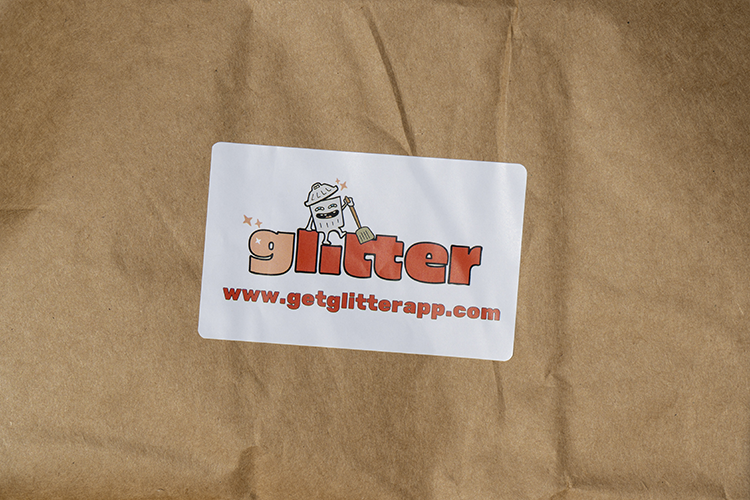Emily Rector had grown accustomed to walking by litter on Philadelphia’s streets.
The South Philly resident had spent years wishing for a practical solution to the city’s trash problem. So when she saw on Instagram that Terrill Haigler, aka “Ya Fav Trashman,” was involved with launching an app to address the problem, Rector was excited.
Haigler and Morgan Berman, founder of the mobile app company MilkCrate, developed Glitter, an app that allows people to subscribe to weekly cleanups, while also paying others to do the cleanups.
Rector immediately signed up to be a cleaner and received an email from Haigler and Berman. She arrived at her first block cleanup in early September with gloves and a trash picker. Her first block was on Bainbridge Street in Southwest Center City, and the experience was positive.

“One of the big draws of this for me is that grassroots appeal,” Rector says. “Where I used to live, the amount of trash that was constantly there, it was just so overwhelming. I desperately wanted to do something.”
Rector says cleaning the block was more than picking up trash; she connected with neighbors and made new relationships.
“One of the big draws of this for me is that grassroots appeal.”
— Emily Rector, Glitter cleaner
“When you explain what you’re doing and explain the app, most people are really cool with it,” Rector says. “Everybody knows Philly trash is a real issue.”
How It Began
For Berman, the idea for Glitter was born on New Year’s Day in 2018. The Philadelphia native found herself walking through the Callowhill neighborhood to meet her friend for brunch, spotting litter at every turn.
It was a lightbulb moment: “I own an app company,” she thought. “We motivate behavior change. We track it. Why can’t I do that for litter?”
Thus, Glitter was conceived.
“The word ‘litter’ is the problem I’ve been trying to solve,” Berman says. The “G” in front was just the right twist.
Berman pitched the idea to the Streets Department, but they passed on funding it. Berman then turned to Haigler.
Haigler is a former city sanitation worker whose social media savvy and success with organizing cleanups around the city have made him an important voice in activism around trash. In 2021 Haigler took his activism full time and began thinking about creating an app as well.
He says he was in a quarterly meeting with his manager, who helps steer his image as a public figure, when he wrote an idea on a whiteboard in a rented office space. Haigler told his manager, “My app will be a better way for people to communicate about trash [pickups] and delays.”
Four months later, Berman sent him an email describing her own idea and the collaboration began.
The app, dubbed “Glitter: Zero Litter,” launched for Android in July and iOS in August. (There’s also a separate back-end app for cleaners called “Glitter Cleaner.”)
Users can sign up for “clean block subscriptions,” a way of directly paying cleaners. The residential block rate is $140 per month for a weekly cleaning, and $220 for a commercial block. Neighbors can cover the costs collectively, which can reduce the individual cost to just a few dollars per month.
Corporate and private giving kickstarted the funding, but the subscription model has since garnered interest from individuals, groups of neighbors and businesses. A recent private donation will allow 35 blocks in Kensington to be cleaned for free for the first month of subscription.
“We want to attract all types of people that need income right now,” Haigler says of recruiting cleaners, noting that the pandemic has left many city residents with financial burdens. He also says that Philly’s high crime rate indicates that people need additional income opportunities.
A Band-Aid for Blight
Though Berman and Haigler hope Glitter will help alleviate the city’s history of poor trash services, neither sees the app as a long-term solution. Ultimately, the amount of trash created must be dramatically reduced.
“Glitter is designed to treat a symptom of a very complicated disease,” Berman says.
Philadelphia is the largest city in America without city-wide street sweeping, and neighborhoods have felt the effects for years. Earlier this year, the Mayor’s Office proposed a budget that included $62 million for cleaning programs, allocating about $11 million per year for five years into several cleaning zones.
Additionally, the Streets Department introduced the Neighborhood Beautification and Litter Taskforce earlier this year. Spokesperson Crystal Jacobs Shipman says the taskforce is still underway. She says its members have been meeting with leadership from the department and other city agencies to formulate neighborhood-specific litter-control plans.
The taskforce shares similarities with Glitter, including some community leaders and stakeholders, to help resolve the litter problem.
“The department looks to build sustainable solutions to litter and trash problems with these groups who … want to identify solutions for the challenges in their communities,” Jacobs Shipman says.
While the city works on the trash issue, Berman, Haigler and their team hope Glitter can offer a helping hand.
“Maybe the city adopts Glitter,” Haigler says, “and maybe it helps their department find an adequate way to communicate [to] residents versus tweeting something every six months and expecting everybody to know how to recycle.”









